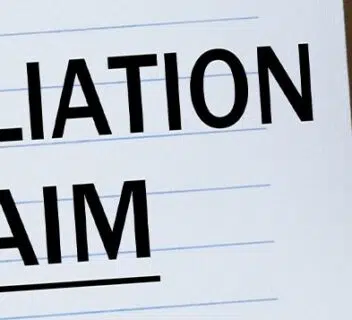Workplace retaliation can be overwhelming, especially if you’ve already gone through the process of reporting something wrong. Retaliation at work happens when your employer punishes you for engaging in a protected activity, such as filing a complaint or reporting workplace discrimination. If you’re in this situation, knowing your rights and next steps can help you protect yourself.
Key Takeaways
- Retaliation happens when an employer punishes you for engaging in legally protected activities, like reporting discrimination or participating in an investigation.
- Common signs include firing, demotion, pay cuts, negative performance reviews, or being excluded from meetings after you’ve made a complaint.
- Laws like Title VII of the Civil Rights Act, the Americans with Disabilities Act (ADA), and the Whistleblower Protection Act protect you from retaliation. The Equal Employment Opportunity Commission (EEOC) enforces these laws.
- Keep detailed records of incidents, communications, and changes in your work situation. This evidence is crucial if you decide to take legal action.
- Before discussing details with Human Resources, consult an employment lawyer to protect your rights and get professional advice on the next steps.
- You generally have 180 days to file a complaint with the EEOC, though some states extend this to 300 days. Missing deadlines can forfeit your rights.
- If you proceed with a case, you may recover lost wages, benefits, compensation for emotional distress, and possibly punitive damages against the employer.
- Contact 1-800-THE-LAW2 for a free consultation with a qualified attorney in our network to discuss your case and explore your legal options.
What is Workplace Retaliation?
Retaliation occurs when an employer punishes an employee for engaging in legally protected activities. This could be filing a complaint about workplace discrimination, participating in an investigation, or opposing unfair practices. Retaliation can take many forms, from firing or demotion to more subtle actions like shift changes or exclusion from meetings.
It’s not always obvious when retaliation occurs. Sometimes, it’s clear, like getting fired. But other times, it can be more subtle. For example, a shift change might seem harmless, but if that change makes it harder for you to balance work and family, it could still be considered retaliation. According to the U.S. Supreme Court, any action that would discourage a reasonable employee from making a complaint is considered illegal retaliation.
If retaliation were allowed, it could stop people from speaking up about unfair treatment, making workplaces even less safe and fair. That’s why retaliation is taken so seriously.
For example, if you report sexual harassment and your boss demotes you afterward, you could have both a harassment and a retaliation claim. Sexual harassment can include unwelcome sexual advances or requests for sexual favors, and if you report such behavior and face negative job actions, it could be considered retaliation. Each claim is separate, but both are important.
Red Flags: Is Your Employer Retaliating Against You?
It’s not always easy to tell if your employer is retaliating. Sometimes, after you report an issue, your supervisor’s attitude may change, but that doesn’t necessarily mean it’s retaliation. For example, if your boss acts more professionally and less friendly after a complaint, that’s not retaliation. However, if your complaint is followed by a negative action like a demotion, pay cut, or exclusion from important meetings, you might be dealing with retaliation.
Retaliation at work can come in many forms, and it’s not always easy to spot. Here are some common signs of workplace retaliation:
- Firing or demoting: You report workplace discrimination, and shortly after, you’re fired or demoted.
- Cutting hours or pay: After raising concerns about unsafe working conditions, your boss reduces your work hours or pay.
- Bad performance reviews: You file a complaint, and suddenly your performance reviews are much worse than they were before.
- Isolating you from coworkers: After you help a coworker file a complaint, your team starts leaving you out of meetings, projects, or group activities.
If you report unlawful discrimination and subsequently face negative job actions, it is important to recognize these as potential signs of retaliation.
In some cases, retaliation can be more subtle, but if you feel like you’re being treated unfairly after taking action to defend your rights, it’s important to look deeper.
Federal Laws and Protections
Federal laws play a crucial role in protecting employees from retaliation in the workplace. The Equal Employment Opportunity Commission (EEOC) enforces several federal laws that prohibit employment discrimination and retaliation. These laws include:
- Title VII of the Civil Rights Act of 1964: This federal law prohibits employment discrimination based on protected categories like race, color, religion, sex, sexual orientation, gender identity, and national origin. It ensures that all employees have equal opportunities in the workplace.
- The Age Discrimination in Employment Act (ADEA): This act protects individuals who are 40 years of age or older from employment discrimination. It ensures that employees are not unfairly treated due to their age.
- The Americans with Disabilities Act (ADA): This law prohibits employment discrimination against individuals with disabilities. It requires employers to provide reasonable accommodations to employees with disabilities.
- The Genetic Information Nondiscrimination Act (GINA): This act prohibits employment discrimination based on genetic information. It ensures that employees are not discriminated against due to their genetic predispositions.
- The Whistleblower Protection Act: This law protects federal employees who disclose information about wrongdoing or illegal activities. It ensures that employees can report misconduct without fear of retaliation. However, it’s important to note that this law applies to federal employees and not to private-sector employees.
These laws prohibit retaliation against employees who engage in protected activities, such as filing a complaint with the EEOC, participating in an EEOC investigation, or opposing discriminatory practices. Employers who retaliate against employees for engaging in these activities can face severe penalties, including financial settlements and civil suits.
Steps to Take After You’ve Encountered Retaliation at Work
If you suspect that your employer is retaliating against you, here’s what you can do:
- Keep records: Save any emails, performance reviews, or other documents that show what happened before and after you reported the issue. This can help prove that retaliation took place.
- Ask for an explanation: Speak with your supervisor or HR to ask why these actions are being taken. It’s possible there’s a legitimate reason, but if they can’t provide one, mention your concerns about retaliation.
- Avoid detailed conversations with HR until you consult a lawyer: It might seem like HR is there to help, but they ultimately work for the company. Talk to a lawyer first to protect your rights before going into too much detail with HR.
- Document everything: Write down dates, names, and what was said or done to you. The more detailed your records are, the stronger your case will be if you decide to take legal action.
- Consult an attorney: Retaliation cases can be tricky. A lawyer can help you understand your options and guide you on the best course of action. Many lawyers offer free consultations.
- File a Complaint with the EEOC: If the issue isn’t resolved internally, you can file a complaint with the Equal Employment Opportunity Commission within 180 days of the retaliatory act.
You can also file a complaint with your state’s labor commissioner. State agencies can also assist with the enforcement of anti-retaliation laws. Keep in mind that laws and procedures can vary by state and situation. Consulting with a qualified attorney will ensure you receive advice tailored to your specific circumstances. Acting quickly is essential to protect your rights!
Proving Retaliation: What You Need to Know About
To prove retaliation, you’ll need to show a link between your complaint and the negative actions taken against you. Here’s how this could be done:
- Gather evidence: Keep track of emails, documents, and any changes in your work situation before and after your complaint.
- Track patterns: Document any negative changes in your workplace, like poor performance reviews, shift changes, or exclusion from meetings.
- Compare treatment: If other employees in similar situations weren’t treated the same way, this could strengthen your case. For example, if another coworker who didn’t file a complaint continues to receive positive reviews while you do not, it could indicate retaliation.
The more evidence you have, the stronger your case will be. If your employer refuses to correct the situation, you may need to take your case to the EEOC or a lawyer. Additionally, filing a civil suit can help uncover underlying motives behind employer actions and seek justice and compensation.
Seeking Help and Support
If you are experiencing retaliation in the workplace, it is essential to seek help and support from qualified professionals. Here are some resources you can turn to:
- The Equal Employment Opportunity Commission (EEOC): The EEOC is responsible for enforcing federal laws that prohibit employment discrimination and retaliation. You can file a complaint with the EEOC online or by contacting your local EEOC office.
- Employment lawyers: An employment lawyer can provide guidance on how to build a strong case and protect your rights under federal law. They can also represent you in court and negotiate a financial settlement on your behalf.
- Employee assistance programs (EAPs): Many employers offer EAPs that provide counseling and support services for employees who are experiencing workplace issues, including retaliation. These programs can offer confidential support and resources.
- Support groups: Joining a support group can provide you with a safe and confidential space to share your experiences and connect with others who have gone through similar situations. Support groups can offer emotional support and practical advice.
Remember, retaliation is a serious issue that can have severe consequences for your career and well-being. Don’t hesitate to seek help and support if you believe you have been retaliated against by your employer.
Compensation in a Retaliation Dispute
Just as employees are protected from retaliation, job applicants are also safeguarded from discrimination and retaliation during the hiring process. If you succeed in a retaliation case, you could be entitled to several types of compensation, known as “damages,” for the losses you’ve experienced due to your employer’s actions. Here’s a breakdown of the most common types of damages you may be able to recover:
Lost Wages
If you were demoted, fired, or had your pay cut because of retaliation, you could seek “back pay,” which covers the wages you lost from the time the retaliation occurred until now. Additionally, if you’re not reinstated to your former position, you may be eligible for “front pay,” which compensates for future lost earnings. In some cases, you might also be able to show that the retaliation has negatively impacted your future career prospects, making it harder for you to find work down the line.
Lost Benefits
If your demotion or pay cut resulted in the loss of benefits, such as health insurance, bonuses, or 401(k) contributions, you can seek compensation for these losses. Benefits tied to your hours worked, like vacation time, may also be recovered if they were reduced due to the retaliatory action.
Pain and Suffering
Retaliation often causes emotional distress, such as stress, anxiety, or damage to your reputation. While these types of damages don’t have a clear dollar amount, they are referred to as “pain and suffering.” To prove emotional harm, a mental health expert may need to testify about the impact the retaliation has had on you. The amount awarded for pain and suffering is ultimately up to the jury, but a lawyer can give you a rough idea based on similar cases.
Punitive Damages
Punitive damages are designed to punish an employer for particularly harmful or reckless behavior. These damages are rare and only awarded in extreme cases where the employer’s actions were especially egregious. Winning punitive damages requires a higher burden of proof, and like pain and suffering, the amount awarded is decided by the jury.
Each case is unique, and the compensation you receive will depend on the specifics of your situation. A lawyer can help you understand what types of damages you may be entitled to and guide you through the legal process.
How Much Time Do I Have to Sue for Retaliation?
You generally have 180 to 300 days to file a retaliation complaint with the EEOC, depending on your state. It’s important to act quickly because missing this deadline could mean losing your right to file a claim.
After filing with the EEOC, they will investigate the situation. If you choose to pursue further legal action, a lawyer can help you navigate the process. If you’re dealing with retaliation at work, don’t wait.
Contact 1-800-THE-LAW2 for a Free Legal Consultation
Dealing with workplace retaliation can be overwhelming, and navigating the legal process can bring unique challenges. That’s why it’s crucial to have an experienced employment lawyer by your side to guide you through your options and help you protect your rights.
Contact 1-800-THE-LAW2 for a free consultation with a qualified attorney in our network. During this initial consultation, you’ll be able to discuss the details of your retaliation case and explore the best course of action. Don’t wait—call us today to get started with your free case evaluation!
We’re here to help you every step of the way.



